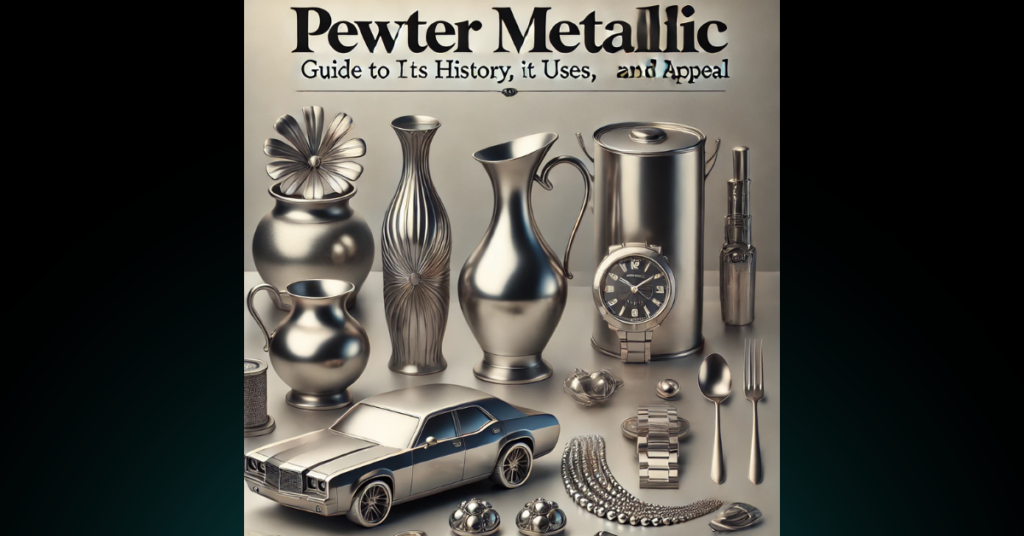Pewter metallic is a unique and versatile material known for its striking appearance and practical applications. Over centuries, pewter has evolved from being a commonplace material in everyday household items to becoming a refined and luxurious choice in various industries. The metallic finish of pewter brings a timeless charm that blends traditional elegance with modern sophistication, making it highly sought after in fields like interior design, automotive, fashion, and jewelry.
This comprehensive guide delves into the history, properties, uses, and care of pewter metallic. Whether you’re considering incorporating pewter metallic into your designs, décor, or products, or you’re simply curious about its appeal, this article will provide valuable insights.
Table of Contents
- What is Pewter Metallic?
- A Brief History of Pewter
- Key Characteristics and Properties
- Common Applications of Pewter Metallic
- Home Décor and Furniture
- Automotive Industry
- Fashion and Accessories
- Jewelry and Collectibles
- Industrial and Technical Uses
- Advantages of Pewter Metallic
- Challenges and Limitations
- How to Incorporate Pewter Metallic into Your Life
- Caring for Pewter Metallic Items
- The Future of Pewter Metallic
- Conclusion
- FAQs
1. What is Pewter Metallic?
Pewter metallic is a term used to describe both the material and its distinct finish. Pewter is an alloy traditionally composed of tin (85–99%) combined with small amounts of copper, antimony, or other metals for added strength and durability. The “metallic” descriptor refers to its lustrous, silvery-gray appearance, which can range from polished and shiny to matte and brushed finishes.
Unlike other metals, pewter is known for its versatility, ease of workability, and ability to achieve intricate designs. Its metallic sheen offers a subtle yet striking appeal that complements a wide variety of styles.
2. A Brief History of Pewter
The use of pewter dates back over 2,000 years to ancient Egypt and Rome. It gained popularity in Europe during the Middle Ages, where it became a common material for household items like plates, goblets, and utensils. At the time, pewter was considered a practical alternative to silver, offering a similar appearance at a fraction of the cost.
During the 17th and 18th centuries, pewter craftsmanship flourished, with intricate designs becoming a hallmark of the material. However, its popularity waned with the advent of porcelain and stainless steel. In recent decades, pewter has experienced a resurgence, particularly in artistic and decorative applications, due to its unique aesthetic and historical charm.
3. Key Characteristics and Properties
Pewter metallic has several distinctive properties that make it a favored choice for various applications:
1. Appearance
- Silvery-gray color with a soft metallic luster.
- Can range from highly polished to matte or brushed finishes.
2. Malleability
- Easy to shape, engrave, or mold into intricate designs.
- Suitable for crafting detailed ornaments and collectibles.
3. Durability
- Resistant to rust and corrosion, making it ideal for long-term use.
- Less brittle than other metals, reducing the risk of cracking or breaking.
4. Lightweight
- Compared to materials like steel or bronze, pewter is lightweight and easier to handle.
5. Lead-Free
- Modern pewter alloys are free from lead, ensuring they are safe for use in tableware and jewelry.
4. Common Applications of Pewter Metallic
Pewter metallic’s is a versatile material used across a wide range of industries and applications.
1. Home Décor and Furniture
Pewter metallic’s is widely used in home décor, where its understated elegance enhances various styles. Common uses include:
- Lighting fixtures like lamps and chandeliers.
- Cabinet hardware, such as knobs and handles.
- Decorative trays, mirrors, and vases.
2. Automotive Industry
In the automotive sector, pewter metallic’s refers to a popular paint finish. Its subdued, neutral tone is used for:
- Car exteriors to achieve a sophisticated and modern look.
- Interior accents like trims and gear knobs.
3. Fashion and Accessories
Pewter metallic’s is a favored choice in fashion for its timeless appeal. Examples include:
- Handbags and shoes with pewter metallic’s finishes.
- Belts, buckles, and watch bands.
4. Jewelry and Collectibles
Pewter is extensively used in crafting jewelry and collectibles due to its ability to be molded into intricate shapes. Applications include:
- Necklaces, rings, and bracelets.
- Keepsake boxes, figurines, and medallions.
5. Industrial and Technical Uses
In addition to decorative purposes, pewter metallic’s has practical applications:
- Used in soldering for electronics.
- Manufacturing small mechanical components.
5. Advantages of Pewter Metallic
Pewter metallic’s offers several advantages that contribute to its widespread popularity:
1. Aesthetic Appeal
The metallic sheen of pewter adds a touch of sophistication and elegance to any item or design.
2. Versatility
Its ability to be molded, engraved, or polished makes it suitable for both decorative and functional uses.
3. Durability
Pewter is highly resistant to rust and corrosion, ensuring longevity even in challenging environments.
4. Eco-Friendly
As a tin-based alloy, pewter is recyclable and sustainable, aligning with eco-conscious values.
5. Cost-Effective
Compared to precious metals like silver, pewter provides a similar appearance at a more affordable price.
6. Challenges and Limitations
While pewter metallic’s has numerous benefits, there are some challenges to consider:
1. Softness
Pewter is relatively soft compared to other metals, making it prone to scratches and dents.
2. Limited Strength
It is not suitable for heavy-duty applications requiring high tensile strength.
3. Susceptibility to Tarnish
Over time, pewter may develop a patina, though some people appreciate this aged appearance.
7. How to Incorporate Pewter Metallic into Your Life
Pewter metallic’s can be used creatively in various aspects of your life. Here are some ideas:
1. Home Décor
Use pewter accents to elevate your home’s style. Try incorporating pewter vases, picture frames, or drawer pulls for a subtle touch of elegance.
2. Fashion Accessories
Add a sophisticated edge to your wardrobe with pewter-toned jewelry or metallic handbags.
3. Automotive
Consider choosing a pewter metallic’s finish for your next car to achieve a sleek, modern aesthetic.
4. Gifts and Collectibles
Pewter keepsakes make meaningful gifts for special occasions like weddings, anniversaries, or graduations.
8. Caring for Pewter Metallic Items
To maintain the beauty of pewter metallic’s items, proper care is essential:
1. Cleaning
- Use warm, soapy water and a soft cloth to clean pewter items.
- Avoid abrasive cleaners or scouring pads that can scratch the surface.
2. Polishing
- For polished pewter, use a non-abrasive metal polish to restore shine.
- Satin or matte pewter should not be polished, as it can alter the finish.
3. Storage
- Store pewter items in a cool, dry place to prevent tarnishing.
- Use protective cloths or cases to avoid scratches.
9. The Future of Pewter Metallic
The appeal of pewter metallic’s is poised to grow as designers and manufacturers continue to explore its potential. Innovations in alloy compositions and finishing techniques are expected to expand its applications in industries such as:
- Sustainable design and eco-friendly products.
- High-end fashion and luxury goods.
- Cutting-edge automotive and interior design.
As consumer preferences shift towards materials that combine aesthetics, functionality, and sustainability, pewter metallic’s is well-positioned to remain a popular choice.
10. Conclusion
Pewter metallic’s is a timeless material that seamlessly blends beauty, functionality, and versatility. From its historical significance to its modern applications in décor, fashion, and industry, pewter continues to captivate with its understated elegance. Whether you’re looking to enhance your home, wardrobe, or product offerings, pewter metallic’s offers endless possibilities.
By understanding its properties, benefits, and care requirements, you can make the most of this unique material and appreciate its enduring appeal.
FAQs
1. What is pewter metallic made of?
Pewter metallic is primarily composed of tin (85–99%) combined with small amounts of copper, antimony, or other metals for added strength.
2. Is pewter metallic safe for food and drink?
Modern pewter alloys are lead-free and safe for use in tableware, such as plates, mugs, and serving trays.
3. Does pewter metallic tarnish over time?
Yes, pewter can develop a patina over time, though this is often considered part of its charm. Regular cleaning can minimize tarnish.
4. How does pewter metallic compare to silver?
Pewter offers a similar appearance to silver but is more affordable and easier to maintain, making it a cost-effective alternative.
5. Can pewter metallic be recycled?
Yes, pewter is recyclable and eco-friendly, making it a sustainable material choice.
6. What are common uses for pewter metallic?
Pewter metallic is commonly used in home décor, fashion accessories, jewelry, automotive finishes, and small industrial components.







